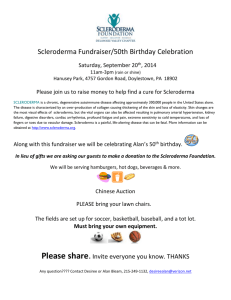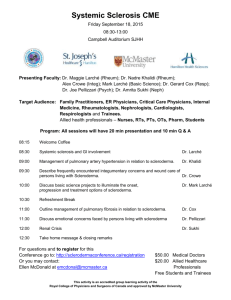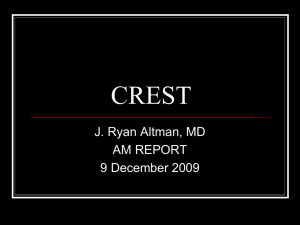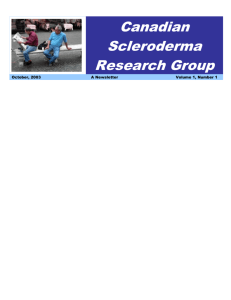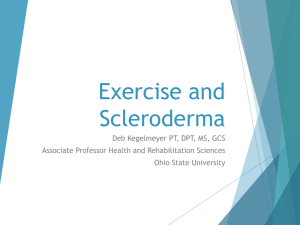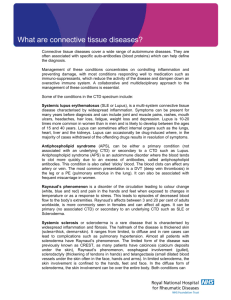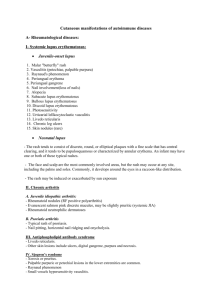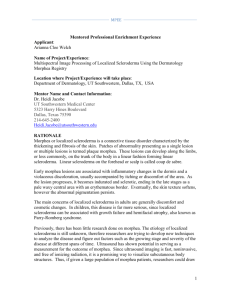Membership Form
advertisement
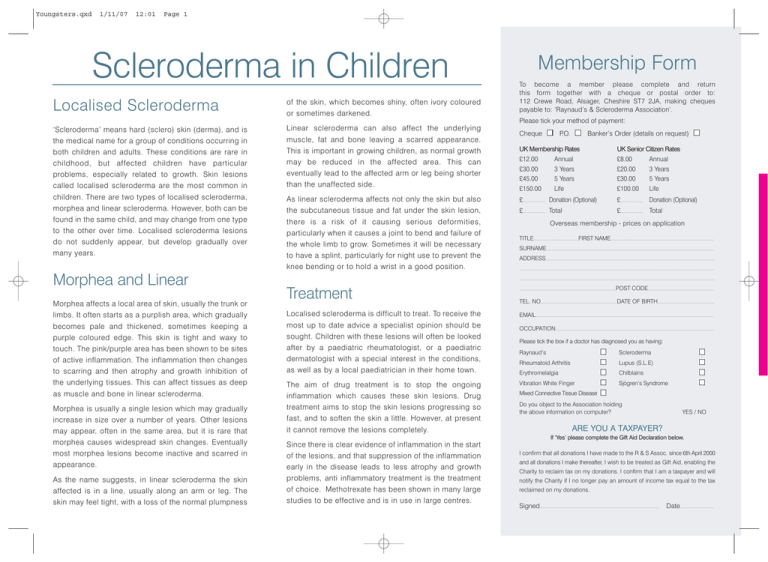
Youngsters.qxd 1/11/07 12:01 Page 1 Scleroderma in Children Localised Scleroderma of the skin, which becomes shiny, often ivory coloured ‘Scleroderma’ means hard (sclero) skin (derma), and is the medical name for a group of conditions occurring in both children and adults. These conditions are rare in childhood, but affected children have particular problems, especially related to growth. Skin lesions called localised scleroderma are the most common in children. There are two types of localised scleroderma, morphea and linear scleroderma. However, both can be found in the same child, and may change from one type to the other over time. Localised scleroderma lesions do not suddenly appear, but develop gradually over many years. Linear scleroderma can also affect the underlying or sometimes darkened. Membership Form To become a member please complete and return this form together with a cheque or postal order to: 112 Crewe Road, Alsager, Cheshire ST7 2JA, making cheques payable to: ‘Raynaud’s & Scleroderma Association’. Please tick your method of payment: Morphea and Linear Morphea affects a local area of skin, usually the trunk or limbs. It often starts as a purplish area, which gradually becomes pale and thickened, sometimes keeping a purple coloured edge. This skin is tight and waxy to touch. The pink/purple area has been shown to be sites of active inflammation. The inflammation then changes to scarring and then atrophy and growth inhibition of the underlying tissues. This can affect tissues as deep as muscle and bone in linear scleroderma. Morphea is usually a single lesion which may gradually increase in size over a number of years. Other lesions may appear, often in the same area, but it is rare that morphea causes widespread skin changes. Eventually most morphea lesions become inactive and scarred in appearance. As the name suggests, in linear scleroderma the skin affected is in a line, usually along an arm or leg. The skin may feel tight, with a loss of the normal plumpness muscle, fat and bone leaving a scarred appearance. Cheque P.O. Banker’s Order (details on request) UK Membership Rates £12.00 Annual £30.00 3 Years £45.00 5 Years £150.00 Life UK Senior Citizen Rates £8.00 Annual £20.00 3 Years £30.00 5 Years £100.00 Life As linear scleroderma affects not only the skin but also £.................... Donation (Optional) £.................... Donation (Optional) the subcutaneous tissue and fat under the skin lesion, £.................... Total £.................... Total This is important in growing children, as normal growth may be reduced in the affected area. This can eventually lead to the affected arm or leg being shorter than the unaffected side. there is a risk of it causing serious deformities, particularly when it causes a joint to bend and failure of the whole limb to grow. Sometimes it will be necessary Overseas membership - prices on application TITLE.............. ..........................FIRST NAME. ............................................................................................ SURNAME........................................................................................................................................................ to have a splint, particularly for night use to prevent the ADDRESS......................................................................................................................................................... knee bending or to hold a wrist in a good position. ................................................................................................................................................................................ ................................................................................................................................................................................ Treatment .......................................................................................POST CODE............................................................ Localised scleroderma is difficult to treat. To receive the most up to date advice a specialist opinion should be sought. Children with these lesions will often be looked after by a paediatric rheumatologist, or a paediatric dermatologist with a special interest in the conditions, as well as by a local paediatrician in their home town. EMAIL................................................................................................................................................................. The aim of drug treatment is to stop the ongoing inflammation which causes these skin lesions. Drug treatment aims to stop the skin lesions progressing so fast, and to soften the skin a little. However, at present it cannot remove the lesions completely. TEL. NO...................................................................... DATE OF BIRTH.................................................... OCCUPATION................................................................................................................................................ Please tick the box if a doctor has diagnosed you as having: Raynaud’s Scleroderma Rheumatoid Arthritis Lupus (S.L.E) Erythromelalgia Chilblains Vibration White Finger Sjögren’s Syndrome Mixed Connective Tissue Disease Do you object to the Association holding the above information on computer? YES / NO ARE YOU A TAXPAYER? If ‘Yes’ please complete the Gift Aid Declaration below. Since there is clear evidence of inflammation in the start of the lesions, and that suppression of the inflammation early in the disease leads to less atrophy and growth problems, anti inflammatory treatment is the treatment of choice. Methotrexate has been shown in many large studies to be effective and is in use in large centres. I confirm that all donations I have made to the R & S Assoc. since 6th April 2000 and all donations I make thereafter, I wish to be treated as Gift Aid, enabling the Charity to reclaim tax on my donations. I confirm that I am a taxpayer and will notify the Charity if I no longer pay an amount of income tax equal to the tax reclaimed on my donations. Signed............................................................................................................ Date............................... Youngsters.qxd 1/11/07 12:01 Page 2 Physiotherapy If a lesion is likely to affect the movement of a joint it is essential to keep the joint moving. A physiotherapist will teach the child and parents an exercise programme to maintain movement. Sometimes careful use of splints aims to improve the position of a joint. However, overuse of splints can aggravate loss of movement. Where a leg has become shorter, a shoe raise will improve the child's gait. This helps the child to run and walk more normally, but also helps with the aches and pains caused by the extra strain on the back, hips, knees and ankles when walking with a limp. Sometimes the difference in leg length can be corrected by surgery. However, this should only be attempted when the child has finished growing, and requires careful discussion to get the timing correct and maximise benefit. Practical Tips There are some simple tricks to make the affected skin look less obvious. Children should always cover up and wear total sun block to protect their skin from the sun, but because the skin in localised scleroderma does not go brown in the sun it looks more obvious with a tan. Teenagers can become very skilled with camouflage make-up to disguise affected skin whether on the face or limbs, and girls may prefer to wear trousers particularly at school. Scleroderma in Children Other forms of scleroderma This leaflet has dealt mostly with localised scleroderma because, although rare, it is the most common type in childhood. There are a number of other conditions with scleroderma-like changes in the skin, but caused by other unrelated conditions such as diabetes, some rare inherited metabolic conditions and even chemical exposure. Systemic sclerosis (also called just scleroderma) is very rare in teenagers and even rarer in younger children. Systemic sclerosis is characterised by widespread skin changes with tight waxy skin, most noticeable on the fingers and face. An Informative Leaflet The word systemic means that it affects the rest of the body, and systemic sclerosis can affect the gullet and gut, and may damage the kidneys and lungs. For this reason these children should be cared for by a specialist centre where they can be monitored carefully, and offered appropriate treatment. Similar skin changes, but not the kidney and lung complications, can be seen in children with related conditions such as dermatomyositis and other connective tissue diseases. These conditions may affect younger children too, who may have problems with weak muscles. Again specialist care is essential for these children. Paediatric rheumatologists and paediatric neurologists have particular expertise in looking after these children. In the management of local disease it is important for all lesions to be carefully noted and also at times to measure the size of a skin lesion as well as the length of the affected limb and the opposite limb. Monitoring in this way is very important to assess the state of the illness and its response to treatment. For just one or two small patches of morphea all that will be needed will be a local cream. If it becomes more generalised other treatment may need to be considered, but this is rare. 112 Crewe Road, Alsager, Cheshire ST7 2JA Tel: 01270 872776 Fax: 01270 883556 Email: info@raynauds.org.uk Website: www.raynauds.org.uk Sponsored by The Ormskirk & Maghull Lions Club Leaflet ref number: SC/M07 Management Published by Raynaud's & Scleroderma Association Charity Reg. No. 326306
